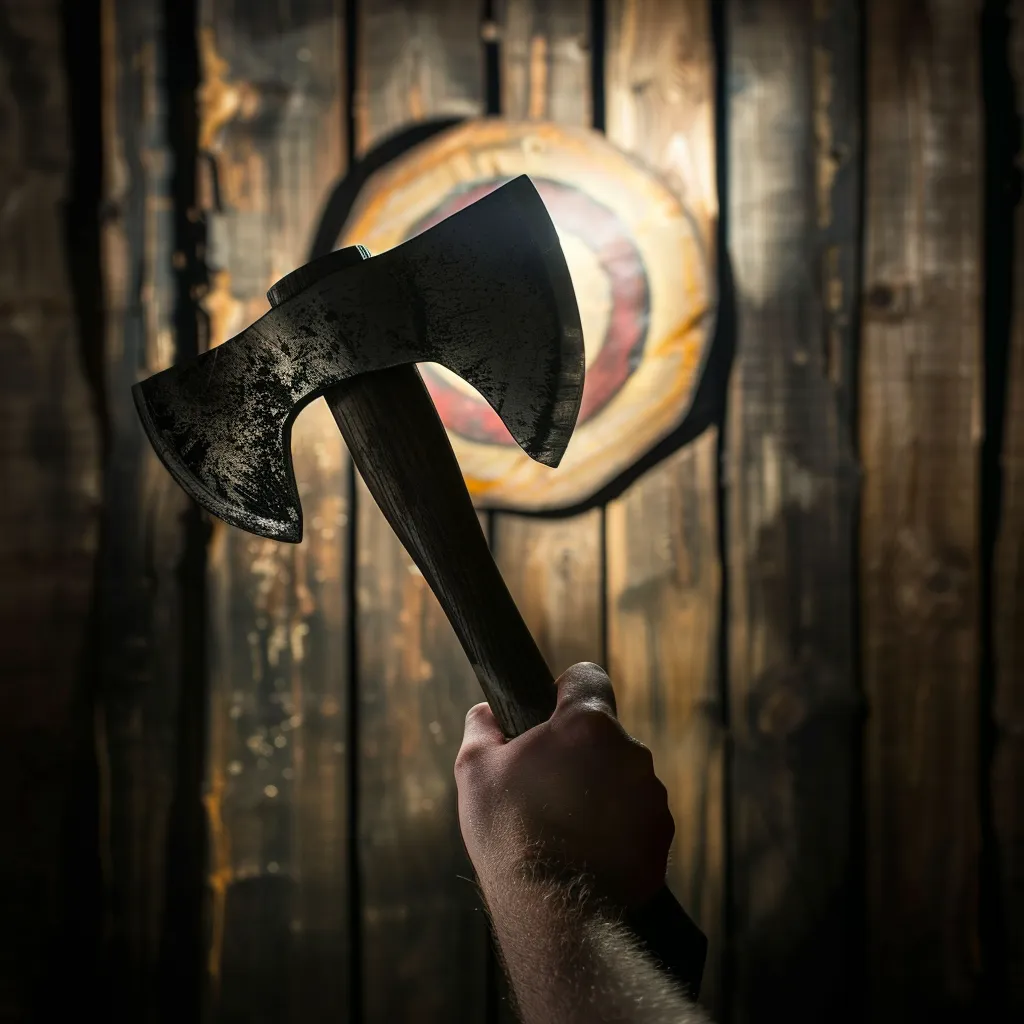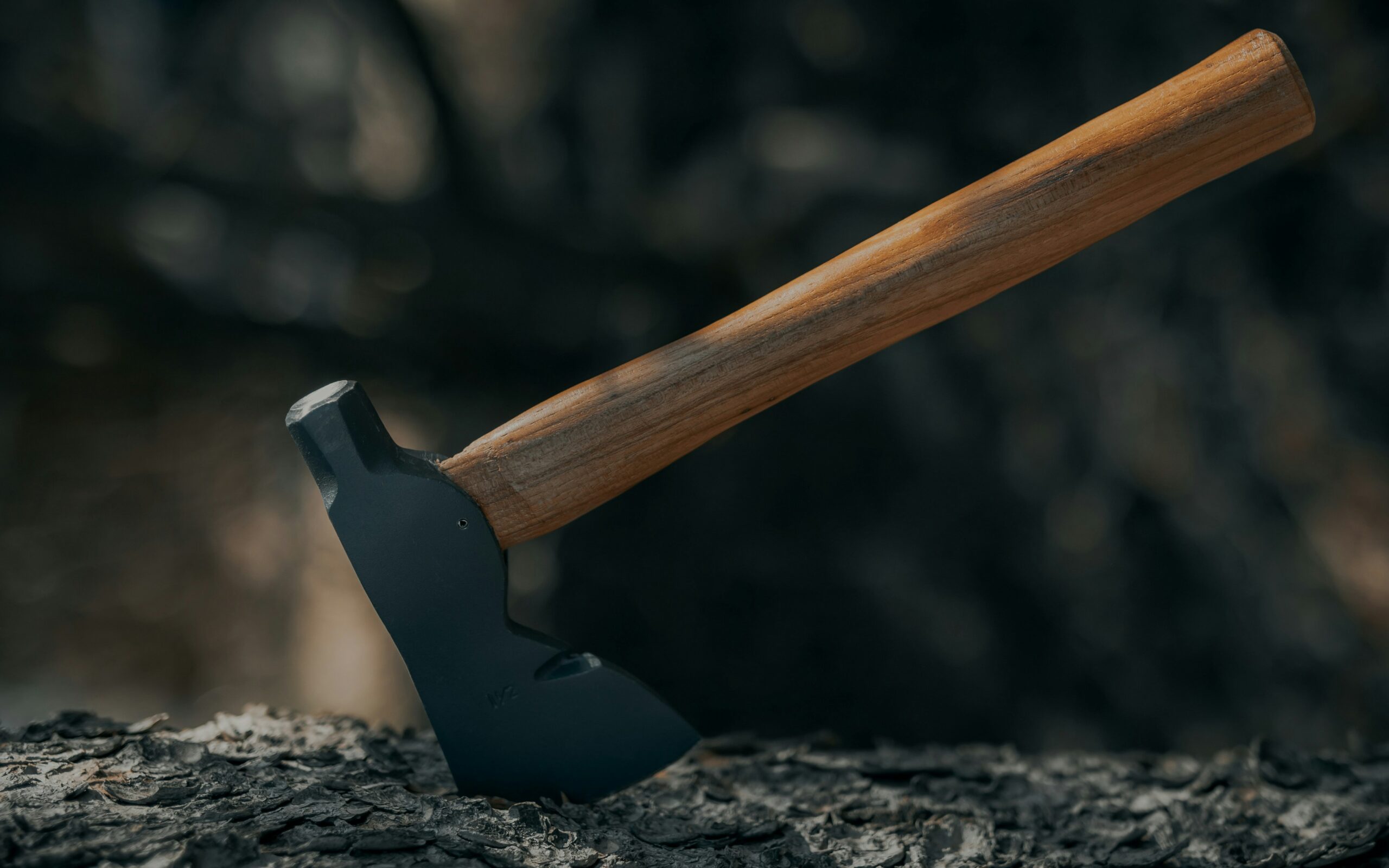Two-handed axe throwing is gaining popularity, but many struggle with proper technique. This guide will help you in mastering two-handed axe throwing, focusing on grip, stance, and release. You’ll learn how to select the right axe, understand weight distribution, and develop a smooth throwing motion.
By following these expert tips, you’ll improve your control and precision, enhancing your two-handed axe throwing skills and enjoyment of this exciting sport.
Key Takeaways
- Two-handed axe throwing improves control and power, combining ancient skills with modern sports techniques
- Proper equipment selection, safety measures, and venue rules are crucial for a safe throwing experience
- Mastering the correct grip, stance, and throwing technique is essential for accuracy and consistency
- Regular practice with structured drills and goal-setting helps improve skills and track progress
- Joining clubs and participating in competitions enhances skills and fosters community engagement in the sport
Understanding the Fundamentals of Two-Handed Axe Throwing

Two-handed axe throwing combines ancient skills with modern sport, offering improved control and power. Beginners should focus on familiarizing themselves with essential terms like “release,” “forearm,” and “throwing axe.” Understanding the history of the sport, the benefits of the two-handed approach, and key terminology provide a solid foundation for mastering this exciting skill.
The Origins and History of Axe Throwing
Axe throwing dates back to ancient times when warriors used hatchets as weapons, focusing on combat effectiveness. The modern sport evolved from lumberjack competitions, where axes were essential work tools, and strength and accuracy were key.
Today, axe throwing emphasizes technique, with throwers adjusting their foot position, grip, and the angle of their throw to achieve accuracy. The thumb plays a crucial role in guiding the axe’s rotation, while proper body mechanics generate the necessary force for a successful throw. The sport has shifted from its origins in combat and competitions to a recreational activity that values precision and technique.
Benefits of the Two-Handed Technique
The two-handed axe throwing technique offers several advantages, providing better control over the axe’s motion and enabling throwers to achieve consistent rotation, increasing their chances of hitting the bullseye. By using both hands, throwers can generate more power and stability, which is especially beneficial for beginners learning to master the sport’s fundamentals.
Essential Terminology for Beginners
Beginners in two-handed axe throwing should familiarize themselves with essential terms to enhance their understanding and safety. Key vocabulary includes “throwing line,” which marks the distance from the target, and “rotation,” referring to the axe’s spin during flight.
A “stick” describes a successful throw where the axe blade embeds in the target, while the “handle” and “head” are crucial parts of the axe that guide its trajectory. Understanding these terms helps novices follow instructions and improve their technique in this challenging sport.
Selecting the Perfect Axe for Two-Handed Throws

Selecting the right axe is crucial for mastering two-handed throwing. This section explores suitable axe types, key factors for choosing, and proper maintenance. Understanding axe weight, handle length, and head design helps optimize spin and momentum. Proper care ensures longevity and consistent performance, allowing throwers to focus on perfecting their wrist technique and wood-splitting accuracy.
Types of Axes Suitable for Two-Handed Throwing
Two-handed axe throwing requires specific types of axes designed for optimal performance. Throwers should consider axes with a handle length between 14 to 19 inches, allowing for a comfortable grip and proper shoulder alignment during the throw.
The axe head typically weighs between 1.5 to 2.5 pounds, influencing the trajectory and spin of the axe in flight. Choosing a well-balanced axe with proper thumb placement options enhances control and accuracy, ensuring better performance during throws.
Factors to Consider When Choosing an Axe
When selecting an axe for two-handed throwing, throwers must consider several key factors that impact performance. The weight distribution between the handle and head, typically between 1.5 and 2.5 pounds, affects the axe’s balance and spin, which is crucial for accurate throws. Handle length, ranging from 14 to 19 inches, plays a vital role in leverage and control, with longer handles providing more power but requiring greater arm strength.
The blade’s shape and sharpness influence the axe’s ability to stick in the target, while the head should be balanced for optimal rotation. Additionally, throwers should choose an axe made from durable steel for longevity, with a comfortable, non-slip grip that suits their physical capabilities and throwing style.
How to Maintain and Care for Your Axe
Proper maintenance of a throwing axe ensures optimal performance and longevity. Throwers should regularly clean the axe head with a wire brush to remove rust and debris, applying a thin coat of oil to prevent corrosion. The handle also requires care; sanding rough spots and applying linseed oil helps maintain its integrity.
Sharpening the blade with a file or whetstone keeps it in top condition, improving its ability to stick in the target. Storing the axe in a dry place and using a protective sheath when not in use prevents damage and ensures it’s always ready for the next throw.
Safety Guidelines for Successful Axe Throwing

Safety is paramount in two-handed axe throwing. This section covers essential protective equipment, creating a secure throwing environment, and following venue rules. Understanding these guidelines ensures a safe and enjoyable experience for all participants, allowing them to focus on improving their throwing technique and accuracy.
Personal Protective Equipment Needed
Proper personal protective equipment (PPE) is essential for safe two-handed axe throwing. Throwers should wear closed-toe shoes to protect their feet from falling axes. Eye protection, such as safety glasses or goggles, guards against wood chips or debris. While not always required, some venues recommend wearing gloves to improve grip and prevent blisters. The following table outlines key PPE items for axe throwing:
Preparing a Safe Throwing Environment
Creating a safe throwing environment is crucial for two-handed axe throwing. Venues should establish a clearly marked throwing line at least 12 feet from the target. The target area must be securely mounted and free from obstructions. Proper lighting ensures visibility, while protective barriers between lanes prevent stray axes from endangering other throwers. Regular equipment checks and maintenance of the throwing area are essential for ongoing safety:
Rules and Etiquette in Axe Throwing Venues
Axe-throwing venues enforce specific rules and etiquette to ensure safety and fair play. Throwers must follow instructions from staff, remain behind the throwing line until given permission to retrieve axes and avoid distracting other participants.
Most venues prohibit alcohol consumption before or during throwing sessions. Proper axe handling, including carrying axes with blades pointed downward and never throwing when others are near the target, is essential. Common venue rules include:
- Only throw when instructed by staff
- Stay behind the throwing line when not throwing
- No horseplay or running in the throwing area
- Report any equipment issues immediately
- Follow proper axe handling and storage procedures
- Respect other throwers and maintain a positive atmosphere
Mastering the Two-Handed Throwing Technique

Mastering two-handed axe throwing requires proper technique and practice. This section covers establishing the correct grip and stance, a step-by-step guide to the throw, common mistakes to avoid, and tips for improving accuracy. By focusing on these key elements, throwers can develop a solid foundation for consistent and precise throws.
Establishing the Correct Grip and Stance
A proper grip and stance form the foundation of successful two-handed axe throwing. Throwers should stand with feet shoulder-width apart, perpendicular to the target, with their dominant foot slightly forward.
The axe is gripped firmly with both hands, the dominant hand near the axe head and the non-dominant hand at the base of the handle. This positioning allows for optimal control and power transfer during the throw while maintaining balance and stability throughout the motion.
Step-by-Step Guide to the Two-Handed Throw
The two-handed axe throw begins with the thrower standing at the throwing line, feet shoulder-width apart. They grip the axe with both hands, the dominant hand near the head and the non-dominant hand at the base. The thrower then raises the axe over their head, leaning back slightly.
As they step forward with their dominant foot, they bring the axe down and forward, releasing it when their arms are fully extended. The key is to maintain a smooth, fluid motion throughout the throw, ensuring the axe rotates once before hitting the target.
Common Mistakes and How to Avoid Them
Novice axe throwers often encounter common mistakes that hinder their progress. These include gripping the axe too tightly, releasing it too early or late, and failing to follow through with the throwing motion.
To avoid these pitfalls, throwers should focus on maintaining a relaxed grip, practicing consistent release timing, and completing the full throwing motion with a smooth follow-through. By addressing these issues, throwers can improve their accuracy and consistency:
- Loosen the grip to allow natural axe rotation
- Release the axe when arms are fully extended
- Follow through with the throwing motion
- Maintain a consistent stance and foot placement
- Keep eyes focused on the target throughout the throw
Tips for Improving Accuracy and Consistency
Improving accuracy and consistency in two-handed axe throwing requires dedicated practice and attention to detail. Throwers should focus on repeating the same motion consistently, paying close attention to their release point and follow-through.
Regular practice sessions, ideally under the guidance of an experienced instructor, can help refine technique and build muscle memory. Throwers can also benefit from mental preparation, visualizing successful throws before stepping up to the line and maintaining a calm, focused mindset throughout the throwing process.
Conclusion
Mastering the art of two-handed axe throwing requires a deep understanding of technique, safety, and practice. This comprehensive guide equips throwers with essential knowledge, from selecting the right axe to executing precise throws and engaging with the axe-throwing community.
By following proper safety guidelines, honing technique through structured practice, and participating in competitions, enthusiasts can elevate their skills and fully embrace this exciting sport.
Ultimately, two-handed axe throwing offers a unique blend of physical challenge, mental focus, and community engagement, making it a rewarding pursuit for those willing to dedicate themselves to the craft.

